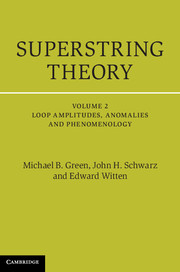Book contents
- Frontmatter
- Contents
- Preface to the 25th Anniversary Edition
- 8 One-loop diagrams in the bosonic string theory
- 9 One-loop diagrams in superstring theory
- 10 The gauge anomaly in type I superstring theory
- 11 Functional methods in the light-cone gauge
- 12 Some differential geometry
- 13 Low-energy effective action
- 14 Compactification of higher dimensions
- 15 Some algebraic geometry
- 16 Models of low-energy supersymmetry
- Bibliography
- References
- String Field Theory
- Index
12 - Some differential geometry
Published online by Cambridge University Press: 05 September 2012
- Frontmatter
- Contents
- Preface to the 25th Anniversary Edition
- 8 One-loop diagrams in the bosonic string theory
- 9 One-loop diagrams in superstring theory
- 10 The gauge anomaly in type I superstring theory
- 11 Functional methods in the light-cone gauge
- 12 Some differential geometry
- 13 Low-energy effective action
- 14 Compactification of higher dimensions
- 15 Some algebraic geometry
- 16 Models of low-energy supersymmetry
- Bibliography
- References
- String Field Theory
- Index
Summary
In the first eleven chapters of this book we have attempted to introduce the reader to string theory as it is presently understood. Our focus now shifts to making contact with more familiar physics. In this chapter we develop some concepts in differential geometry that are useful in understanding general relativity and Yang-Mills theory even in four dimensions, but which are of particular utility in ten-dimensional physics. Our treatment in this chapter is comparatively elementary and aims mostly to develop the minimum material we require in chapters 13 and 14. In chapter 13, we will discuss supergravity theory in ten dimensions, which at least in perturbation theory is the low-energy limit of ten-dimensional superstring theory. In chapter 14, we will discuss some of the important ideas that arise in compactification from ten to four dimensions. The concluding chapters of this book, chapters 15 and 16, are devoted to more specialized mathematical background and more speculative ideas about compactification.
Spinors In General Relativity
A good place to start our discussion is to think about the coupling of spinors to a gravitational field. This problem is of great importance in string theories in which both fermions and gravity are present, and this alone would justify its consideration here. In addition, thinking about the coupling of spinors to a gravitational field forces us to examine issues whose analogs for Yang-Mills theory we will wish to consider later. The question of coupling spinors to general relativity was considered briefly in chapter 4, in connection with a discussion of two-dimensional supergravity, but here we will be more extensive.
- Type
- Chapter
- Information
- Superstring Theory25th Anniversary Edition, pp. 271 - 306Publisher: Cambridge University PressPrint publication year: 2012



